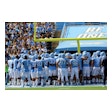Can Forward-Thinking Administrators Prevent Athletic Hazing?

News item: Three members of the Trumbull (Conn.) High School wrestling team-including two captains-face adult charges of assault and conspiracy for allegedly hog-tying younger wrestlers, pushing them against walls, stuffing them inside lockers and dumping garbage on them last December. One boy was even held down while teammates forced the handle of a plastic knife into his rectum. A total of eight boys were arrested, some on charges that could land them a five-year stay in prison.
News item: Upperclassmen Alexis Holden and Tiquon Clay blindfolded several junior varsity football players at Stevenson High School in Lincolnshire, Ill., and then sat naked on their faces last August. Instead of facing a maximum penalty of six months in jail, they pleaded guilty to a reduced charge of disorderly conduct and were sentenced to a community-service program. They also were ordered to write apologies and essays about respect.
News item: A year earlier, at William Tennent High School in Warminster, Pa., seven wrestlers bound and beat a teammate, exposed his genitals and also sat naked on his face. One of the wrestlers, James Cooker, was expelled, and the lawsuit that followed was filed not by Cooker's victim but by Cooker himself-against his new school, Pennridge, for refusing to allow him to wrestle for one season. The suit was eventually thrown out of a county court. Three alarming incidents, two disparate punishments and one major problem.
Hazing rituals, or rites of initiation, are becoming more dangerous both in and out of America's high school locker rooms. National headlines may focus on stories like last fall's brutal hazing episode involving the University of Vermont's hockey team, in which nine freshmen were forced to drink warm beer, perform nude push-ups while dipping their genitals into strategically placed cups of beer and parade naked in an "elephant walk" while holding each other's genitals. But many high school student athletes also are suffering, sometimes in silence, thanks to lax administrators and unaware parents.
"A lot of hazing goes on without parents even knowing about it," says Alice Haben, whose son, Nicholas, died in 1990 from alcohol poisoning after a lacrosse club drinking ritual at Western Illinois University. Today, Alice speaks to various groups about the hazards of hazing. "I didn't even know what hazing was until my son died," she says. "I had no idea that kind of crap went on."
Hazing has been around for "more than 2,000 years," says Hank Nuwer, an adjunct professor of journalism at Indiana University-Purdue University in Indianapolis and Anderson (Ind.) University, as well as a hazing authority who's written three books on the subject-including last year's Wrongs of Passage: Fraternities, Sororities, Hazing and Binge Drinking (Indiana University Press) and the justpublished High School Hazing: When Rites Become Wrongs (Franklin Watts). "But what one generation tolerates, the next will accelerate."
Indeed, a 1999 Alfred University study of initiation rites in college sports revealed that 80 percent of student-athletes polled claimed they experienced questionable or unacceptable hazing incidents in college. Of those, 42 percent also reported being hazed in high school, and 5 percent said they were hazed in middle school.
The need among high school freshmen and junior varsity players to be accepted by older teammates is great, and enduring hazing rites has become the accepted price to pay. "The kids being hazed hate it," says Tim Flannery, assistant director of the National Federation of State High School Associations, which leaves hazing policies up to individual districts. "But once they make it through, they get this feeling of success, and they can't wait to do the same thing to other kids next year. For a lot of kids, it's their badge of courage; now they belong. And it's worth all the pain and suffering."
That pain and suffering-much of it unreported-can range from relatively innocent behavior such as covering student-athletes in whipped cream or shaving their heads, to far more dangerous activities involving the taping of body parts, theft, alcohol abuse and sexual misconduct. Stories of brutal paddling, simulated sexual acts involving pompom and cheerleading squad members, swimming through sewage, same-sex rapes similar to the ones performed by Trumbull wrestlers and near-fatal marathon drinking sessions are becoming more common, Nuwer says.
Even more disturbing is that some coaches, athletic directors and administrators continue to turn a blind eye toward hazing, viewing it as a harmless, traditional and integral element of building team unity. Some even blame the victims. For example, teammates of football player Brian Seamons, a sophomore at Sky View (Utah) High School in October 1993, taped him at the wrists, ankles, genitals and neck to a towel rack, and then paraded classmates-and, worse, a girl he was dating-past him.
When Seamons complained to his coach and later refused to apologize to teammates for reporting the incident, he was suspended from the team. When the district superintendent heard about the incident, he canceled the rest of the football season. And when the student body found that out, classmates threatened and harassed Seamons, who eventually transferred schools.
More recently, the principal of Deerfield (Wis.) High School failed to report an incident involving the taping of a freshman baseball player to a bench, where he was threatened with being urinated on by an older player whose pants were already unzipped. According to published reports, the principal didn't consider the incident to be "a police matter."
And at Meeker (Colo.) High School, a freshman wrestler was stripped, tied with duct tape, sprayed around his genitals and anus with a medicated ointment used to toughen skin around blisters and then carried to the gym, where the girls' basketball team was practicing. His coach failed to intervene, copping a "boys-will-be-boys attitude," according to Nuwer. That lack of discipline cost the coach his state teacher's license.
Other coaches have lost their jobs or been suspended simply because of their naïveté. The inability of one highly respected and successful Watertown (Mass.) High School coach to believe that his players would force teammates to race with cookies between their buttocks resulted in his one-year suspension. "I feel we're probably going to lose some very good coaches who have put their hearts and souls into coaching, because they didn't think through all of the ramifications of hazing," Nuwer says. "Hazing is accepted among students-and if coaches accept it, that's trouble."
Some districts have adopted zero-tolerance policies, but many officials still fear that talking to student-athletes about hazing will plant ideas in their heads. "That's just an old way of thinking," says Flannery, who suggests developing written anti-hazing policies. "Lay out the rules, the risks and the consequences." "There's no getting around the fact that kids have heard about hazing," Nuwer adds. "They've seen Dazed and Confused and Animal House." Among the preventive measures Nuwer and Flannery suggest:
- Realize how much control athletic administrators have and exercise it. Wanting to belong on a team is important-that's why many hazing incidents happen in the first place. So the threat of being kicked off a team for inappropriate behavior can be sobering.
- Encourage team leaders, especially captains, to talk to the rest of the team about the hazards of hazing. While captains were at fault in the Trumbull incident, many others are born leaders, and teammates respect leaders.
- Conduct exit interviews with departing seniors and players who have been cut. They can offer objective reports about team and locker-room behavior because they no longer have a vested interest in being part of the team.
- Discourage negative traditions. If student-athletes must partake in rituals, suggest they begin a new one with a team barbecue, during which time captains and other seniors positively reinforce what it means to be a member of an elite group, that hard work is expected, and that with hard work comes respect from teammates.
- Propose anti-hazing laws to legislators and fight for their passage.
Hazing can end where it typically begins-in the locker room-when coaches, athletic directors and administrators pay attention to student-athletes' behavior and watch for signs of trouble, Nuwer says. "We need to look at hazing without hysteria. We just can't be reactive. I would like to head this off, because awareness by kids and coaches can help keep careers and lives from being ruined Something as stupid as hazing."
































